| Pages:
1
2 |
Abromination
Hazard to Others
  
Posts: 432
Registered: 10-7-2018
Location: Alaska
Member Is Offline
Mood: 1,4 tar
|
|
Fume Hood Blower Installation
After much thought, I have decided on the fume-hood centrifugal blower I wish to use. The only problem with it is that it does not come with a power
cord and is meant to be hard wired directly into a furnace or wood stove. Does anyone have any suggestions on how to do the wiring? I have some
experience in this but not enough to be confident.
https://www.amazon.com/dp/B07DWBC1GY/ref=sspa_dk_detail_1?ps...
List of materials made by ScienceMadness.org users:
https://docs.google.com/spreadsheets/d/1nmJ8uq-h4IkXPxD5svnT...
--------------------------------
Elements Collected: H, Li, B, C, N, O, Mg, Al, Si, P, S, Fe, Ni, Cu, Zn, Ag, I, Au, Pb, Bi, Am
Last Acquired: B
Next: Na
-------------- |
|
|
wg48temp9
National Hazard
   
Posts: 784
Registered: 30-12-2018
Location: not so United Kingdom
Member Is Offline
|
|
Its got a label on the side showing the power connections ???
What is it you need to know or are not confident about ?
PS: That type of blower in not recommended for a fume hood because the motor is mounted in the air flow and could ignite inflammable vapours.
[Edited on 12/28/2019 by wg48temp9]
I am wg48 but not on my usual pc hence the temp handle.
Thank goodness for Fleming and the fungi.
Old codger' lives matters, wear a mask and help save them.
Be aware of demagoguery, keep your frontal lobes fully engaged.
I don't know who invented mRNA vaccines but they should get a fancy medal and I hope they made a shed load of money from it.
|
|
|
Abromination
Hazard to Others
  
Posts: 432
Registered: 10-7-2018
Location: Alaska
Member Is Offline
Mood: 1,4 tar
|
|
Motor is not mounted in the airflow, which is exactly why I was considering this model. This is not an in line fan, and part of the point of a
centrifugal fan is to keep the motor out of the airflow. I am also aware that the label shows the power power connections, I just dont want to connect
it directly to ac power without knowing first. It could be fine, but its safer to check then to waste 100 bucks.
If I wanted absolutely isolation from the motor, I would buy one with a belt like the one Magpie had. I am purposely not doing that because shipping
costs at least 500 dollars for any model I have seen to my location.
EDIT: I stand corrected, the motor is actually in the way of the airflow. Its not very apparent with the provided pictures, But I could see it in the
customer pics at the bottom.
I found a better option anyways, with directions (in the comments) for ac wiring.
[Edited on 12-29-19 by Abromination]
List of materials made by ScienceMadness.org users:
https://docs.google.com/spreadsheets/d/1nmJ8uq-h4IkXPxD5svnT...
--------------------------------
Elements Collected: H, Li, B, C, N, O, Mg, Al, Si, P, S, Fe, Ni, Cu, Zn, Ag, I, Au, Pb, Bi, Am
Last Acquired: B
Next: Na
-------------- |
|
|
wg48temp9
National Hazard
   
Posts: 784
Registered: 30-12-2018
Location: not so United Kingdom
Member Is Offline
|
|
Many tumble dryer blowers have the motor outside of the impeller housing (not in the air flow) and most are thrown away because the drum bearing is
faulty, the drum belt is broken or have a door problem. Meaning the blower still works. The owners are usually happy if you offer to haul it away.
As bonus you get the sheet steel of the housing and perhaps the plastic trunking used for ducting the damp air outside. Obviously metal trunking is
safer if you do have a fire.
I am wg48 but not on my usual pc hence the temp handle.
Thank goodness for Fleming and the fungi.
Old codger' lives matters, wear a mask and help save them.
Be aware of demagoguery, keep your frontal lobes fully engaged.
I don't know who invented mRNA vaccines but they should get a fancy medal and I hope they made a shed load of money from it.
|
|
|
Abromination
Hazard to Others
  
Posts: 432
Registered: 10-7-2018
Location: Alaska
Member Is Offline
Mood: 1,4 tar
|
|
Quote: Originally posted by wg48temp9  | | Many tumble dryer blowers have the motor outside of the impeller housing (not in the air flow) and most are thrown away because the drum bearing is
faulty, the drum belt is broken or have a door problem. Meaning the blower still works. The owners are usually happy if you offer to haul it away.
As bonus you get the sheet steel of the housing and perhaps the plastic trunking used for ducting the damp air outside. Obviously metal trunking is
safer if you do have a fire. |
Ive done quite a bit of searching around and really haven’t found anyone with one they were offering to give away. If I see something pop up I’ll
gladly take it. The problem I have with metal is the corrosion caused by acid vapors. I’m not particularly concerned with solvent vapors, I usually
try to recover as much as possible. I’m pretty happy with this other one I have found (again on amazon).
List of materials made by ScienceMadness.org users:
https://docs.google.com/spreadsheets/d/1nmJ8uq-h4IkXPxD5svnT...
--------------------------------
Elements Collected: H, Li, B, C, N, O, Mg, Al, Si, P, S, Fe, Ni, Cu, Zn, Ag, I, Au, Pb, Bi, Am
Last Acquired: B
Next: Na
-------------- |
|
|
draculic acid69
International Hazard
    
Posts: 1371
Registered: 2-8-2018
Member Is Offline
|
|
I've just built a fumehood (sort of) but am disappointed with the low flow but I think adding another fan would help only I don't have 60 or so
dollars for another fan so the dryer fan blower sounds good.ill look into that.i can probably pick one up cheap.
|
|
|
wg48temp9
National Hazard
   
Posts: 784
Registered: 30-12-2018
Location: not so United Kingdom
Member Is Offline
|
|
Below is a pic of a typical dryer blower.
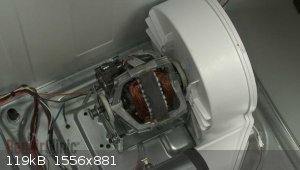
Please note that the motor frame tends be be insulated from its mounting bracket by rubber bushes and some times not grounded. It should be grounded
(earthed) to reduce static pickup and for electrical safety reasons.
Unfortunately they are induction motors so the speed can not be controlled easily. They are frequently arranged to run in alternative directions by
reversing the polarity of one of the wingdings. That does mean that the impeller is bi directional and probably less efficient than ones with curved
blades. If you must have simple speed control you could replace the motor with a DC brushed motor from a washing machine with a spin cycle but
fitting the impeller could be tricky.
I am wg48 but not on my usual pc hence the temp handle.
Thank goodness for Fleming and the fungi.
Old codger' lives matters, wear a mask and help save them.
Be aware of demagoguery, keep your frontal lobes fully engaged.
I don't know who invented mRNA vaccines but they should get a fancy medal and I hope they made a shed load of money from it.
|
|
|
Abromination
Hazard to Others
  
Posts: 432
Registered: 10-7-2018
Location: Alaska
Member Is Offline
Mood: 1,4 tar
|
|
Ohh by dryer you actually do mean a clothes dryer, I thought you meant one of the fans they use to dry out water from flood damage. Surely that cant
produce enough cfms, but I will look out for one.
List of materials made by ScienceMadness.org users:
https://docs.google.com/spreadsheets/d/1nmJ8uq-h4IkXPxD5svnT...
--------------------------------
Elements Collected: H, Li, B, C, N, O, Mg, Al, Si, P, S, Fe, Ni, Cu, Zn, Ag, I, Au, Pb, Bi, Am
Last Acquired: B
Next: Na
-------------- |
|
|
wg48temp9
National Hazard
   
Posts: 784
Registered: 30-12-2018
Location: not so United Kingdom
Member Is Offline
|
|
Quote: Originally posted by Abromination  | | Ohh by dryer you actually do mean a clothes dryer, I thought you meant one of the fans they use to dry out water from flood damage. Surely that cant
produce enough cfms, but I will look out for one. |
At first I used "tumble dryer" and mentioned a drum and a door . But yes using the phrase a "clothes tumble dryer" and or picture would have been
better and reduced the chance of a misunderstanding.
I don't know what air flow is required for a fume hood and I don't know the air flow of a dryer blower so I don't know if it would be sufficient or
not.
The best we can do is compare it with the $100 blower you previously selected. Both use a four pole motor and the dryer motor is much larger but
not smaller so that suggests a similar power rating (the dryer motor has to rotate the drum in a addition to pushing the air). The Impellers are a
similar size and rotating at similar velocities that suggests they will have similar flow rates.
So I guesstimate the flow rates will be within a factor of two or perhaps 3 the same.
It would be nice to know the flow rate so I may try to measure it. It can be done by dropping a small piece of paper into the inlet of the blower and
seeing how long it takes to be blown out of a length of ducting. Perhaps with different lengths of ducting would be useful too.
I am wg48 but not on my usual pc hence the temp handle.
Thank goodness for Fleming and the fungi.
Old codger' lives matters, wear a mask and help save them.
Be aware of demagoguery, keep your frontal lobes fully engaged.
I don't know who invented mRNA vaccines but they should get a fancy medal and I hope they made a shed load of money from it.
|
|
|
draculic acid69
International Hazard
    
Posts: 1371
Registered: 2-8-2018
Member Is Offline
|
|
Now that I think about it a clothes dryer fan is more of a slow steady stream of air and an exhaust fan needs to be a lot faster moving than a clothes
dryer.unless the blower can speed up to a necessary speed without the drum turning mechanism slowing it down.
|
|
|
wg48temp9
National Hazard
   
Posts: 784
Registered: 30-12-2018
Location: not so United Kingdom
Member Is Offline
|
|
Quote: Originally posted by wg48temp9  |
The best we can do is compare it with the $100 blower you previously selected. Both use a four pole motor and the dryer motor is much larger but
not smaller so that suggests a similar power rating (the dryer motor has to rotate the drum in a addition to pushing the air). The Impellers are a
similar size and rotating at similar velocities that suggests they will have similar flow rates.
So I guesstimate the flow rates will be within a factor of two or perhaps 3 the same.
It would be nice to know the flow rate so I may try to measure it. It can be done by dropping a small piece of paper into the inlet of the blower and
seeing how long it takes to be blown out of a length of ducting. Perhaps with different lengths of ducting would be useful too.
|
I got round to measuring the flow rate using the method above.
With 9ft (+ 1ft for the blower path) of 4in dia plastic ducting attached to the blow a small piece a paper sucked in to the blower inlet appears very
quickly at the end of the ducting. Its so quick its hard to estimate the time. I estimate it is no slower than 0.25s but perhaps as fast as 0.125s.
That gives a flow rate of bewteen 210 to 420 CFM that comperes well to the 463 CFM of the $100 blower. However we do not know under what condition
the 463 CFM is specified. The blower replaces the Dayton 1TDR9 which specifies the a flow rate of 463 CFM with no back pressure (no ducting).
I checked two other fume hood threads and both were using about 400CFM blowers
At almost no flow of 50 CFM the pressure is specified as 0.6 in (presumably water head). With the dryer blower blocked off by my hand using a plastic
tube part filled with water I measure the difference in water height between the end of the tube held in the blocked output of the dryer blower and
the
other end of the tube as 0.75 in. Again similar to $100 blower.
The dryer blower I tested was from a discarded dryer that was noisy probably because in had a small plastic toy figure stuck in the blower blades and
was rubbing on part of the housing.
I was thinking I could video the paper going in and then out and count the frames. I should also measure the back pressure of 9ft of 4in dia ducting.
If I repeat the experiment I will use dye and detergent in the water. I would also like to try a Venturi tube to measure the flow but I guess a
smooth transition is required to maintain laminar flow.
See https://www.grainger.com/product/DAYTON-OEM-Blower-1TDR9
Calculation: 
PS: I looked up the flow resistance of ducting at https://www.engineeringtoolbox.com/duct-friction-pressure-lo...
Apparently at a flow of 400CFM 10ft of 4in dia ducting would have a pressure drop of 0.9in which exceeds the maximum pressure of the blower. This
suggests the flow probably closer to 210 CFM than 400CFM.
[Edited on 1/10/2020 by wg48temp9]
[Edited on 1/10/2020 by wg48temp9]
I am wg48 but not on my usual pc hence the temp handle.
Thank goodness for Fleming and the fungi.
Old codger' lives matters, wear a mask and help save them.
Be aware of demagoguery, keep your frontal lobes fully engaged.
I don't know who invented mRNA vaccines but they should get a fancy medal and I hope they made a shed load of money from it.
|
|
|
Abromination
Hazard to Others
  
Posts: 432
Registered: 10-7-2018
Location: Alaska
Member Is Offline
Mood: 1,4 tar
|
|
My blower came in today, I ended up buying one for cheaper, with better reviews and higher cfms.
The motor is totally isolated from the air flow and the blade piece should be removable for cleaning. If I can figure out a good, temporary window
mount, the blower will vent directly outside instead of pushing air through the duct first, insuring minimal leakage for imperfect seals in the duct.
The duct itself is vinyl, which will have to be replaced after a few years. I do not foresee myself pumping a huge amount of corrosives or flammables
from the fumehood, but its a nice security when I have to. Better to be able to work inside then in the weather we have here (-15°F here right now)
For the reference of others, the idea of using a dryer blower is not at all a bad one.
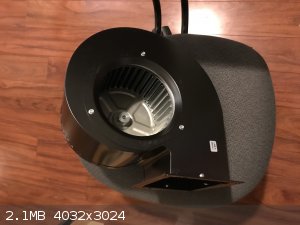
List of materials made by ScienceMadness.org users:
https://docs.google.com/spreadsheets/d/1nmJ8uq-h4IkXPxD5svnT...
--------------------------------
Elements Collected: H, Li, B, C, N, O, Mg, Al, Si, P, S, Fe, Ni, Cu, Zn, Ag, I, Au, Pb, Bi, Am
Last Acquired: B
Next: Na
-------------- |
|
|
wg48temp9
National Hazard
   
Posts: 784
Registered: 30-12-2018
Location: not so United Kingdom
Member Is Offline
|
|
I was surprised how much resistance to air flow 10ft of 4in dia ducting produces.
Below is a graph plotting the back pressure versus air flow of a blower Dayton 1TDR9 (triangular data points). I also plotted the back pressure of
10ft of 4in dia ducting, 4ft of that ducting and the back pressure of 4ft of 6in dia ducting, respectively the top middle and bottom graphs on the
right. The intersection of the blower graph with each of the ducting graphs indicates the air flow for that ducting using the blower.
As can be seen from the graphs the air flow of the blower is approximately halved for 10ft of 4in ducting. While 4ft of 6in ducting has almost no
reduction.
Enginerringtoolbox.com gives the air flow resistance of round ducting as approximately inversely proportional to the fifth power of the duct
diameter.
Putting it differently about 7.6ft of 6in ducting has the same back pressure
as 1ft of 4in ducting at the same air flow.
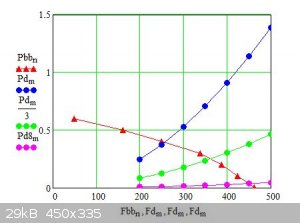
I am wg48 but not on my usual pc hence the temp handle.
Thank goodness for Fleming and the fungi.
Old codger' lives matters, wear a mask and help save them.
Be aware of demagoguery, keep your frontal lobes fully engaged.
I don't know who invented mRNA vaccines but they should get a fancy medal and I hope they made a shed load of money from it.
|
|
|
Sulaiman
International Hazard
    
Posts: 3697
Registered: 8-2-2015
Location: 3rd rock from the sun
Member Is Offline
|
|
One problem ... every cubic foot of air expelled through the fan/blower draws into the room a similar volume of external atmospheric air,
which requires a significant cost in either heating (in this case) or cooling (in hotter climates)
CAUTION : Hobby Chemist, not Professional or even Amateur
|
|
|
XeonTheMGPony
International Hazard
    
Posts: 1640
Registered: 5-1-2016
Member Is Offline
Mood: No Mood
|
|
HRV, and a fresh air intake into the hood. that will turn the hood into a mostly freezer in winter!
You should see a kitchen when the MUAU Heater fails, the hood becomes a massive frost ball even with all gas equipment at full burn!
|
|
|
Abromination
Hazard to Others
  
Posts: 432
Registered: 10-7-2018
Location: Alaska
Member Is Offline
Mood: 1,4 tar
|
|
Quote: Originally posted by Sulaiman  |
One problem ... every cubic foot of air expelled through the fan/blower draws into the room a similar volume of external atmospheric air,
which requires a significant cost in either heating (in this case) or cooling (in hotter climates) |
Ive thought about that and I am already pretty limited in the chemistry I can do in the winter. That wouldn't ever be a problem in the summer.
List of materials made by ScienceMadness.org users:
https://docs.google.com/spreadsheets/d/1nmJ8uq-h4IkXPxD5svnT...
--------------------------------
Elements Collected: H, Li, B, C, N, O, Mg, Al, Si, P, S, Fe, Ni, Cu, Zn, Ag, I, Au, Pb, Bi, Am
Last Acquired: B
Next: Na
-------------- |
|
|
S.C. Wack
bibliomaster
    
Posts: 2419
Registered: 7-5-2004
Location: Cornworld, Central USA
Member Is Offline
Mood: Enhanced
|
|
A chemical resistant paint such as a spray paint for engines can be applied.
|
|
|
draculic acid69
International Hazard
    
Posts: 1371
Registered: 2-8-2018
Member Is Offline
|
|
I'm using a 4" inline rule brand diesel exhaust fan for a boat in my so far unused hood.
Is there anything that i should know about like the difference between the one pictured above and the inline type i have?
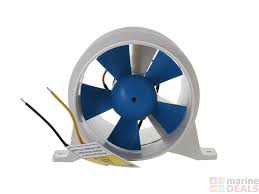
|
|
|
Sulaiman
International Hazard
    
Posts: 3697
Registered: 8-2-2015
Location: 3rd rock from the sun
Member Is Offline
|
|
This fan uses brushes so there will be some sparking that could ignite flammable gasses or vapours.
Plus, the motor is in the exhaust stream, so it is exposed to any corrosives or contaminants in your airflow,
which could damage the motor body, windings, commutator, bearings etc.
CAUTION : Hobby Chemist, not Professional or even Amateur
|
|
|
draculic acid69
International Hazard
    
Posts: 1371
Registered: 2-8-2018
Member Is Offline
|
|
It's a sparkless one that's meant for fuel vapour so I'm not worried about explosions and it's coated in black plastic vynil so won't corrode(for a
while at least). it says it can do 200cfm which is a bit on the low end for a fumehood i think.
|
|
|
Abromination
Hazard to Others
  
Posts: 432
Registered: 10-7-2018
Location: Alaska
Member Is Offline
Mood: 1,4 tar
|
|
The blower is ready to be installed, and I have high hopes for a very efficient hood. Sitting loose and unattached on the top of the hood, the lowest
setting is capable of pulling a tissue from the sash into the fan (I intend not to let go again). I am going down a slightly different rout then I
initially planned. Instead of permanently sealing the blower to the top of the hood or on the output (board in window) with flexible ducting, the
blower will have a few inches of rectangular, wooden duct venting directly outside with the blower on top of the hood. To make this removable, the
blower will sit on top of a rubber gasket with the heavy weight to make a seal. This way I can remove the board fro the window when I have to leave
for a while or when its cold in the winter.
I have found that flexible ducting severely limits the fans ability to move air, so this will be a potential solution.
[Edited on 1-26-20 by Abromination]

List of materials made by ScienceMadness.org users:
https://docs.google.com/spreadsheets/d/1nmJ8uq-h4IkXPxD5svnT...
--------------------------------
Elements Collected: H, Li, B, C, N, O, Mg, Al, Si, P, S, Fe, Ni, Cu, Zn, Ag, I, Au, Pb, Bi, Am
Last Acquired: B
Next: Na
-------------- |
|
|
XeonTheMGPony
International Hazard
    
Posts: 1640
Registered: 5-1-2016
Member Is Offline
Mood: No Mood
|
|
flexible ducting is garbage, it is only really used by lazy cheap contractors! (No surprise I am seeing it every where now days)
Any bumps seams or ridges create turbulence, this turbulence generates back pressure, you want your runs to be as smooth as possible and 90 degrees
are a no no, you want to use the slightest radius you can to achieve a turn.
Swept 90 is better, 45 degrees better yet but for the short paths best option is a long swept 90, 4inch pvc will be superior to any flexible ducting
(Lets not forget if you need the fume hood the flexible ducting is easily damaged and not acceptable risk!)
Long story short, Smooth strait pipe with gradual angle changes that is rigid will give the best result for any system configuration.
|
|
|
wg48temp9
National Hazard
   
Posts: 784
Registered: 30-12-2018
Location: not so United Kingdom
Member Is Offline
|
|
Here are some quantitative values for the effects of bends in ducts in terms of equivalent length of ducting. For example a single right angle bend in
10ft of ducting restricts the air flow the same as 30ft of straight ducting. Two right angle bends and the equivalent is 50ft. Wow thats a
significant, so yes right angle bends can restrict the flow very significantly. However the effect can be reduced by increasing the duct diameter. If
you have bends at least double the duct diameter.
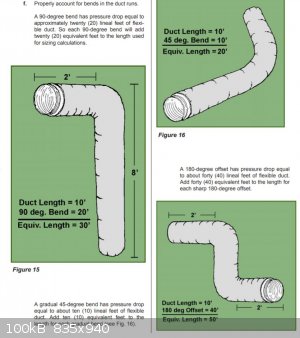
From: https://flexibleduct.org/images/ADC~IR5E.pdf
I am wg48 but not on my usual pc hence the temp handle.
Thank goodness for Fleming and the fungi.
Old codger' lives matters, wear a mask and help save them.
Be aware of demagoguery, keep your frontal lobes fully engaged.
I don't know who invented mRNA vaccines but they should get a fancy medal and I hope they made a shed load of money from it.
|
|
|
Abromination
Hazard to Others
  
Posts: 432
Registered: 10-7-2018
Location: Alaska
Member Is Offline
Mood: 1,4 tar
|
|
Not only did the flexible ducting require three bends (4ft of length) but it didn’t directly adapt to the square outlet. I must have lost 300cfms
from it. It should funtion at near full potential with a short amount of square duct. The surface area inside was so great, i imagine the turbulance
would reduce the airflow another hundred cmfs by itself. I’m not going to bother calculating the loss, its just not worth my time.
Thanks all for the insight.
List of materials made by ScienceMadness.org users:
https://docs.google.com/spreadsheets/d/1nmJ8uq-h4IkXPxD5svnT...
--------------------------------
Elements Collected: H, Li, B, C, N, O, Mg, Al, Si, P, S, Fe, Ni, Cu, Zn, Ag, I, Au, Pb, Bi, Am
Last Acquired: B
Next: Na
-------------- |
|
|
Abromination
Hazard to Others
  
Posts: 432
Registered: 10-7-2018
Location: Alaska
Member Is Offline
Mood: 1,4 tar
|
|
Quick update:
The gasket seal works very well. The plastic foam like material was tested with various solvents and corrosives and is very resistant. The weight of
the fan on top of the motor makes a very good seal, and will make the fan easily removable and serviceable. It has also made the hood much more quiet
and seems to have raised the cfms by quite a bit. I also have noticed very little turbulence inside of the hood body itself, even above the sash
opening and around the baffles. When I get a chance, I will construct the outlet ducting and the window piece.
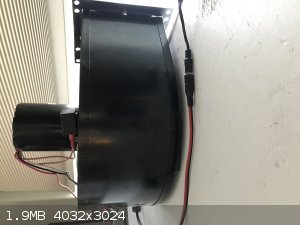
List of materials made by ScienceMadness.org users:
https://docs.google.com/spreadsheets/d/1nmJ8uq-h4IkXPxD5svnT...
--------------------------------
Elements Collected: H, Li, B, C, N, O, Mg, Al, Si, P, S, Fe, Ni, Cu, Zn, Ag, I, Au, Pb, Bi, Am
Last Acquired: B
Next: Na
-------------- |
|
|
| Pages:
1
2 |
|